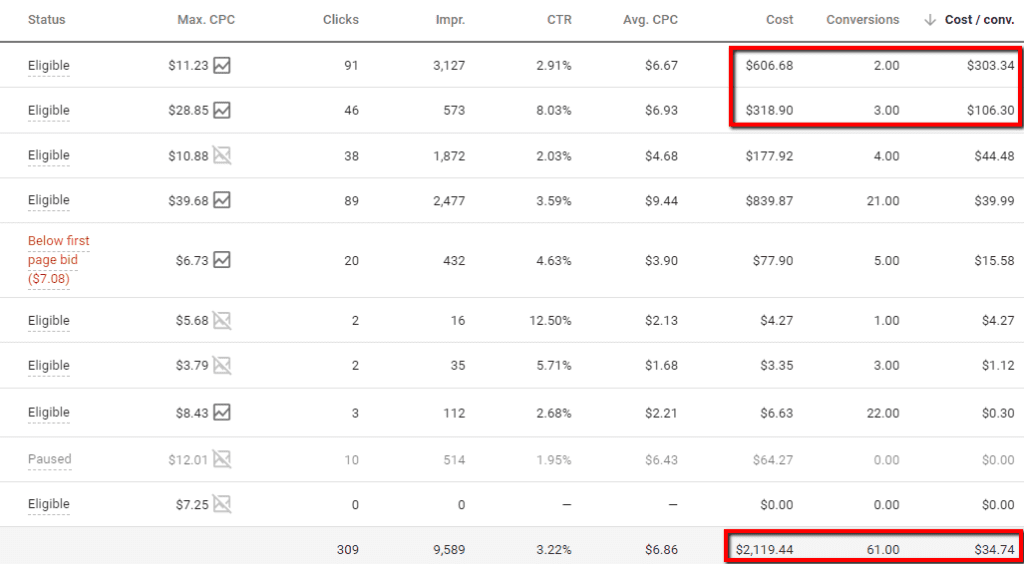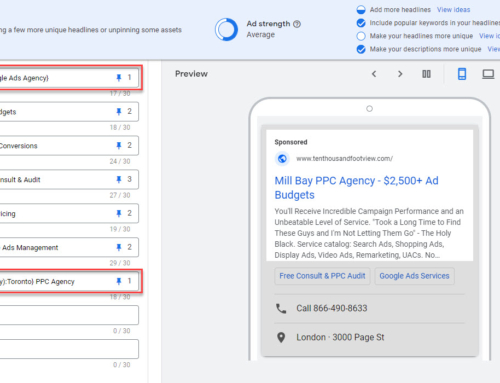Is your mandate to reduce spending on Google Ads and lower CPA down to a more affordable level? Here are the 10-steps you can take today to immediately and dramatically reduce your spending and CPA. These are provided in order of greatest to least impact.
1. Stop Low Performing Campaigns
Depending on how much you wish to reduce ad spend, you may want to simply pause low performing campaigns completely. Display & video campaigns (other than for remarketing) are great for branding and consideration but rarely generate many conversions. Consider shutting these down, at least temporarily, until you wrangle your numbers. Likewise, if you have search campaigns that cost substantially more in terms of CPA, you might want to place those on hold for now.
2. Reduce Keyword Bids
Doing this alone can generally reduce your CPA to whatever level you want. How much you lower your bids will depend on your current average ad positions and where you’re at with respect to your new target ad spend. If your campaign is “limited by budget” you can probably make substantial bid reductions before your ad spend is affected.
Consider making a global bid adjustment such as -25% across the board. Note, however, that reducing bids 25% does not equal reducing your ad spend or CPA by 25%. You should also cherry-pick keywords with high spend and high CPA for larger adjustments. Just as important, is protecting high performing keywords, those that generate conversions at well below average CPAs. After the change, if a high number of keywords drop below page-1 bids you might want to bump them back up to the bottom of page-1.
3. Pause Low Performing Keywords
Find keywords with at least 5 conversions and a CPA that’s 2X or more of your average. You could reduce bids by half and let them run, but we’re making deep cuts. Let’s just pause all of these for the time being. Also, if you have some keywords that are exceeding 4X of your average CPA and haven’t ever converted or maybe just once or twice, it’s time to shut those down.
In the example below, we have two keywords that are making up nearly 44% of ad spend and contributing just 8% of conversions. It would be prudent to pause the highlighted keywords.
4. Replace Broad Match Keywords
This task may take a little time. Select each of your high volume broad match keywords one at a time and then view the search terms report for each one. If there are a wide array of low relevance search terms you should consider replacing the keyword with a Broad Match Modified or Phrase Match variation.
If you’re only seeing a few low-quality search queries we’re going to deal with that in the next step.
5. Add Negative Keywords
Select all of your keywords and pull up the search terms report. We’re going to sort a few different ways and cut wasted ad spend:
Sort by clicks (most to least)
Scroll through your search terms and find those that have generated a lot of clicks but no/low conversions. Add these as exact match negative keywords.
Sort by CPA (highest to lowest)
Find the search terms with at least 3 conversions that are way over your target CPA, such as 3-4X and add them as negative exact match keywords.
Sort by CTR (lowest to highest) and filter for impressions > 100
Find low CTR search terms and add them exact match negatives. These are dragging down your average CTR for related keywords, and that’s costing you higher average CPCs and resulting in lower ad positions.
6. Optimize Device Bid Adjustments
If you’re getting say 80% of your clicks from mobile devices, but they convert at 1.5X your average CPA we need to fix this. In this exact case, set a -33% bid adjustment for mobile. Also, don’t forget to implement offsetting bid adjustments for the remaining devices. This will bring your CPA into line with the average and apply more of your ad dollars to the higher performing computer and tablet devices where you have higher conversion rates.
7. Adjust Demographics Targeting
Pull up your demographics reports and display your conversions and CPA metrics. If you’re paying an exorbitant CPA for some ages, genders, or income levels you should either exclude those demographic segments or at least set a negative bid adjustment for them. As with devices, also set positive bid adjustments for the best performing demographic groups.
8. Turn Off Partner Network Targeting
Check your Network (with search partner) segment performance and compare CPA for each campaign. Where Search Partner performance is significantly lagging you should turn off Search Partners targeting to cut costs. The change probably won’t be dramatic, since Partner Networks drive an average 10% of total clicks.
In this example, we see that the CPA is over double for Search Partners. Interestingly, a CPA of $24 is still well below the average for this account and our new target of $50. It makes sense, therefore, to continue targeting search partners in this campaign. An important takeaway here is that you have to consider the account as a whole when comparing KPIs within a single campaign or ad group.
9. Adjusting Location Targeting
Besides the obvious, optimizing bid adjustments by location, you may want to make other adjustments if you target locally. Pull up a geographic report and see if visitors from further away are costing you a higher CPA. If so, you can either eliminate targeting those locations, shrink your radius, or (preferred) create concentric radiuses with negative bid adjustments the further away you go from center.
10. Adjust Ad Schedules
Optimizing for this one tends to be specific to certain business types. In this case, I’m not talking about setting bid adjustments for different times based on CPA performance – you should already be doing this by the way. What I’m suggesting is limiting your campaigns to run at certain times. For B2Bs that often means disabling campaigns on weekends and possibly outside of business hours. For consumer businesses, that means only running campaigns when you’re open.
Summary
These optimization steps are aggressive and will cut wasted ad spend fast. As a result, you’ll spend less and see much lower CPAs. Be careful when you implement these, as you’ll also be reducing your overall opportunities for conversions. If your goal is to reduce CPA without reducing ad spend, this is not the right direction for you.







